2025 Building Code Solar Installations: Winter Guide
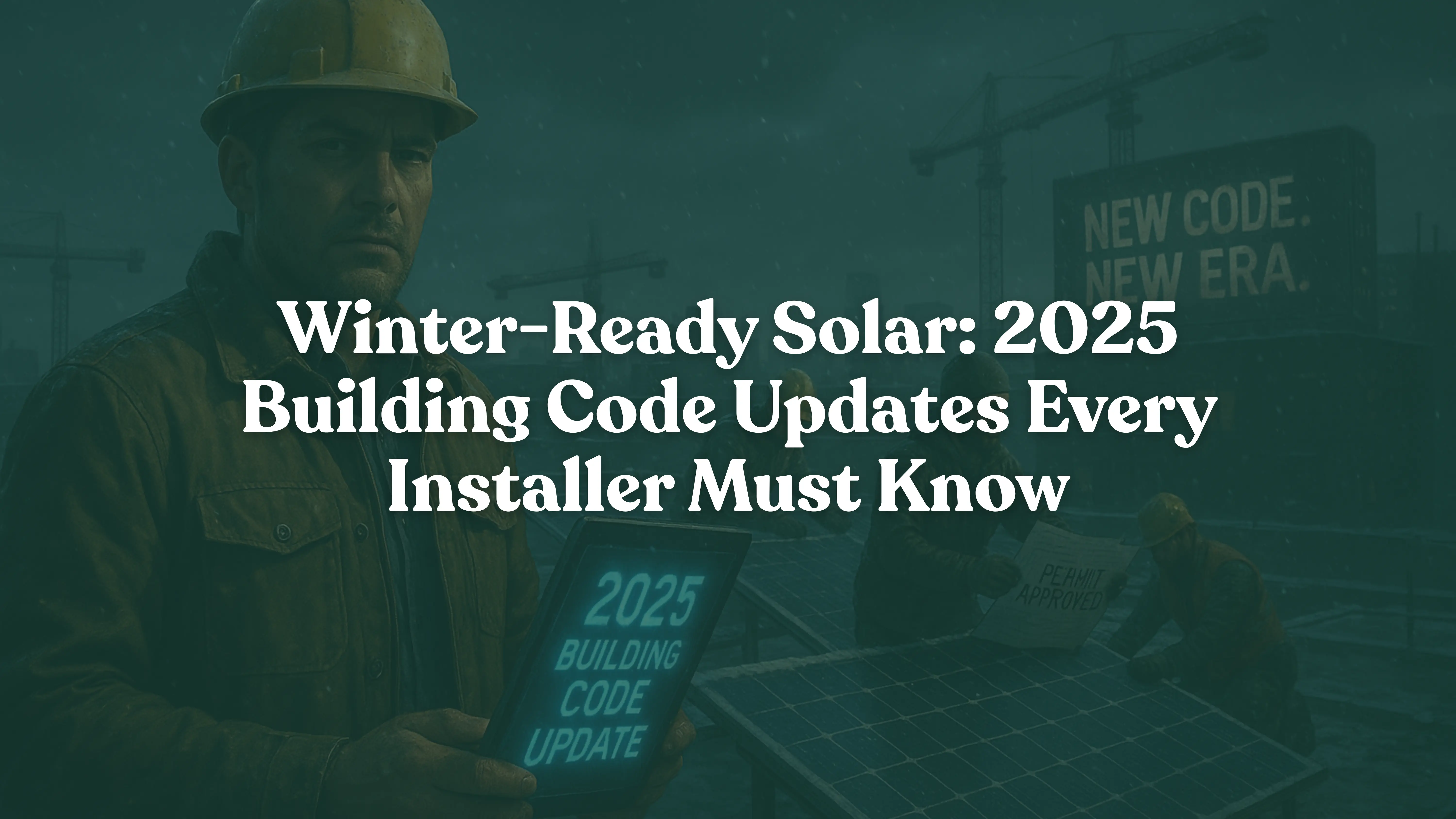
2025 Building Code Solar Installations: Winter Weather Standards Every Installer Must Master
What Changed in 2025 Building Code Solar Installations?
If you’re a solar installer or EPC contractor, 2025 building code solar installations bring significant changes you can’t ignore. Moreover, the landscape of solar permitting has evolved with stricter winter weather standards that directly impact your bottom line.
The solar industry is experiencing massive growth—global installations surged 64% in the first half of 2025 according to Ember’s latest energy report. However, this growth comes with increased regulatory scrutiny. Furthermore, building officials are taking winter performance standards more seriously than ever.
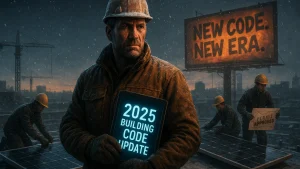
Here’s the reality: installers operating on outdated code knowledge face permit denials, project delays, and potential liability issues. Therefore, understanding these changes isn’t optional—it’s essential for business survival.
Understanding ASCE 7-22: The New Foundation for Winter Weather Standards
What is ASCE 7-22 for Solar Installations?
ASCE 7-22 represents the most significant update to structural load requirements in years. Specifically, this standard from the American Society of Civil Engineers provides detailed methodologies for calculating wind, snow, and seismic loads on buildings.
Consequently, the 2024 International Building Code (IBC) and International Residential Code (IRC) now reference these updated standards. As a result, your 2025 building code solar installations must meet higher performance thresholds.
How Do Snow Loads Affect Solar Panel Installation?
Snow loads combine three critical weight factors:
- Dead loads: The permanent weight of panels, racking, and mounting hardware
- Live loads: Temporary weight from maintenance crews and installation equipment
- Environmental loads: Snow accumulation, ice buildup, and seasonal variations
Additionally, the California Energy Commission now references ASCE 7-16 Chapter 7 Snow Loads requirements. Indeed, meeting these standards determines whether your project qualifies for certain exemptions.
Regional Snow Load Variations in 2025
Different regions face drastically different requirements. For instance:
| Region | Typical Snow Load | Code Adoption Status | Special Requirements |
|---|---|---|---|
| California Coastal | 0-5 psf | Adopted January 2026 | Title 24 compliance mandatory |
| Colorado Mountains | 30-100+ psf | Effective July 2026 | Enhanced structural calcs required |
| Northeast States | 25-70 psf | Varies by jurisdiction | Ice dam considerations |
| Southern States | 0-10 psf | Limited adoption | Wind loads primary concern |
California’s Title 24: What Are the New Solar Building Codes for 2025?
Expanded Solar Mandate Requirements
California’s 2025 Energy Code brings sweeping changes to 2025 building code solar installations. Most importantly, the updated standards now require solar for high-rise multifamily buildings with four or more habitable stories.
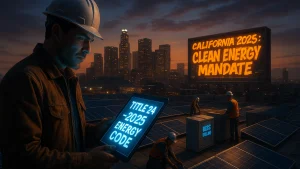
According to the California Energy Commission’s official announcement, these updates will save $4.8 billion in energy costs over their lifetime. Additionally, they’ll reduce greenhouse gas emissions by approximately 4 million metric tons.
Assembly Buildings Now Need Solar
Furthermore, Title 24 updates solar and storage standards for assembly buildings. This includes:
- Religious worship facilities
- Sports arenas and recreation centers
- Convention centers
- Auditoriums
Consequently, these buildings must maximize onsite clean energy use while minimizing grid exports. Therefore, installers need experience with larger commercial systems and battery integration.
Battery Energy Storage System (BESS) Requirements
Here’s a critical change: many 2025 building code solar installations now require battery storage systems. Specifically, high-rise multifamily and certain nonresidential buildings must include BESS unless they meet specific exemptions.
This requirement creates opportunities but also complexity. After all, battery systems have unique temperature considerations. Moreover, lithium-ion batteries perform poorly in extreme cold without proper climate control.
Colorado’s New Building Standards: Mountain-Specific Challenges
Model Low Energy and Carbon Code Takes Effect
Colorado published its Model Low Energy and Carbon Code in September 2025. Subsequently, this becomes the state’s minimum building code on July 1, 2026.
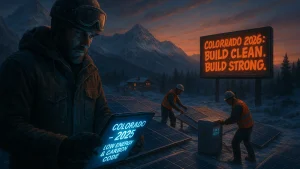
Progressive Energy Offset Requirements
Colorado’s approach uses tiered requirements based on home size:
- Under 5,000 sq ft: Meet baseline energy efficiency standards
- 5,000-7,499 sq ft: Enhanced efficiency requirements
- Over 7,500 sq ft: Must offset total energy use with onsite solar or purchase offsite clean energy
Therefore, luxury mountain home installers face the most stringent requirements. Additionally, these properties offer excellent solar potential due to ample roof space.
High-Altitude Installation Considerations
Mountain installations bring unique challenges for 2025 building code solar installations:
- Intense UV exposure damages components faster
- Dramatic temperature swings stress mounting systems
- Snow loads significantly exceed flatland calculations
- Wind forces multiply at higher elevations
Consequently, installers must specify premium components rated for extreme conditions. Moreover, proper engineering becomes non-negotiable.
Essential Compliance Requirements for 2025 Building Code Solar Installations
UL Certification and Equipment Standards
All components in your 2025 building code solar installations must meet updated certification standards. Specifically:
Photovoltaic Panels: Listed and labeled per UL 1703 or both UL 61730-1 and UL 61730-2
Inverters: Listed and labeled according to UL 1741 standards
Mounting Systems: Certified per UL 2703 and installed following manufacturer specifications
Furthermore, systems connecting to the utility grid require inverters specifically listed for utility interaction.
Structural Engineering Documentation
Your permit package must include comprehensive structural analysis showing:
- Roof load capacity calculations: Can the existing structure handle additional weight?
- Wind load analysis: What forces will the array experience during storms?
- Snow load calculations: How much accumulated snow must the system withstand?
- Seismic considerations: Will the installation remain secure during earthquakes?
Additionally, many jurisdictions require a licensed Professional Engineer (PE) stamp on structural calculations. Therefore, building partnerships with qualified structural engineers becomes crucial.
Fire Code Compliance: Access and Setbacks
Fire safety requirements significantly impact 2025 building code solar installations. For example, the International Residential Code mandates:
- Clear pathways not less than 36 inches wide to emergency escape openings
- Setbacks from roof edges to allow firefighter access
- Spacing requirements between panel arrays
- Compliance with local fire marshal specifications
Moreover, Building Integrated Photovoltaic (BIPV) systems have different requirements than traditional rack-mounted installations.
Practical Implementation: Your Step-by-Step Compliance Checklist
Pre-Design Phase
Step 1: Research jurisdiction-specific code adoption status
- Check when your local area adopted 2024 IBC/IRC
- Review any local amendments to model codes
- Contact building department for interpretation guidance
Step 2: Conduct thorough site assessment
- Document existing roof condition and age
- Measure roof slope and orientation
- Identify potential structural concerns
- Note any penetrations or obstacles
Design Phase
Step 3: Run comprehensive load calculations
- Calculate dead loads for all equipment
- Determine live loads per code requirements
- Research local snow load data from weather records
- Calculate wind loads based on building height and exposure
Step 4: Select appropriate equipment
- Choose panels rated for local climate conditions
- Specify mounting systems meeting load requirements
- Select inverters with proper certifications
- Plan battery placement if required
Permitting Phase
Step 5: Prepare complete documentation package
- Stamped structural calculations from PE
- Manufacturer specification sheets
- Site plans showing array placement
- Electrical one-line diagrams
- Fire safety compliance documentation
Step 6: Submit and respond promptly
- Submit complete package to avoid delays
- Respond quickly to plan review comments
- Schedule pre-construction meetings if available
- Build relationship with building officials
Common Pitfalls in 2025 Building Code Solar Installations
Mistake #1: Assuming Old Standards Still Apply
Many installers learned their trade under previous code cycles. However, ASCE 7-22 represents a significant departure from earlier standards. Consequently, using outdated calculation methods leads to permit denials.
Mistake #2: Ignoring Regional Variations
Building codes aren’t one-size-fits-all across the country. Instead, each state and local jurisdiction adopts codes on different timelines. Furthermore, many areas add local amendments to model codes.
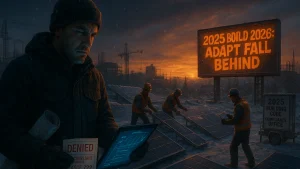
Mistake #3: Inadequate Winter Weather Planning
Snow and ice create challenges beyond simple weight calculations. For instance:
- Ice dams form at panel edges
- Snow slides concentrate loads in unexpected areas
- Freeze-thaw cycles damage improperly sealed penetrations
- Cold temperatures affect sealant curing times
Mistake #4: Poor Documentation
Building officials need complete information to approve permits. Therefore, submit comprehensive packages including:
- Professional stamped engineering documents
- Complete manufacturer specifications
- Clear site plans and diagrams
- Proof of equipment certifications
Moreover, organized documentation speeds up approval processes and demonstrates professionalism.
The Business Case for Code Compliance Excellence
Competitive Advantage Through Expertise
Installers who master 2025 building code solar installations gain significant competitive advantages. Specifically:
- Faster permit approvals reduce project timelines
- Fewer inspection failures lower costs
- Enhanced reputation attracts better clients
- Reduced liability protects your business
Additionally, expertise in complex jurisdictions opens markets competitors avoid.
Risk Mitigation and Liability Protection
Non-compliant installations create massive liability exposure. For instance:
- System failures during winter storms
- Structural damage from excessive loads
- Fire safety violations
- Insurance claim denials
Consequently, investing in proper engineering and documentation protects both your business and your clients.
Long-Term Performance and Customer Satisfaction
Systems designed to exceed minimum code requirements perform better over decades of operation. Furthermore, satisfied customers provide referrals and repeat business.
Looking Forward: What’s Next for Solar Building Codes?
Continuing Code Evolution
Building codes update every three years following a predictable cycle. Therefore, forward-thinking installers prepare for future changes rather than reacting to them.
The trend is clear: requirements will continue becoming more stringent. Moreover, climate change drives increased focus on extreme weather resilience.
Industry Best Practices
Leading installers don’t just meet minimum codes—they exceed them. For example:
- Design for 10-20% higher loads than required
- Use premium components in critical applications
- Implement redundant safety features
- Document everything thoroughly
Additionally, building relationships with structural engineers, building officials, and other professionals strengthens your capabilities.
Winter-Ready. Code-Ready. Market-Ready—with Energyscape Renewables.
Winter code changes raise the bar for safe, durable solar—so don’t treat them as red tape. Energyscape Renewables delivers winter-focused engineering and permit-ready plan sets (snow-load calculations, tilt/rack specs, battery siting, PE stamping, AHJ-ready documentation) so your projects pass permits and perform through decades of freeze-thaw cycles.
We’re an all-in-one partner: engineering, structural checks, permitting & interconnection support—plus rapid turnarounds to keep schedules tight. Pair that with Sunscape (Site Survey App + CRM) to capture precise field data, automate compliance checklists, and move from survey to stamp to install without rework.
Short version: meet the 2025 codes confidently, protect crews and customers, and win more winter work—Energyscape + Sunscape handle it all in one place. Ready to update your winter specs?

sjayakanth@energyscaperenewables.com